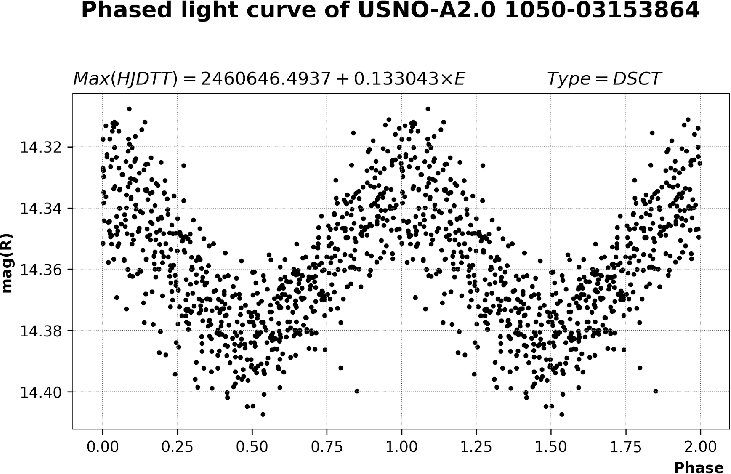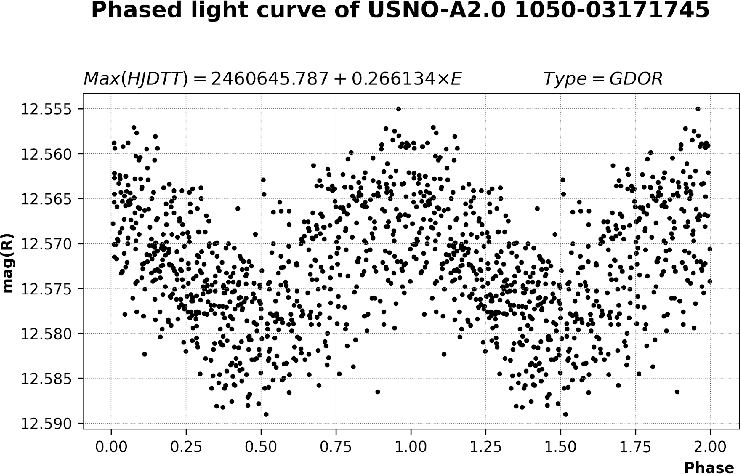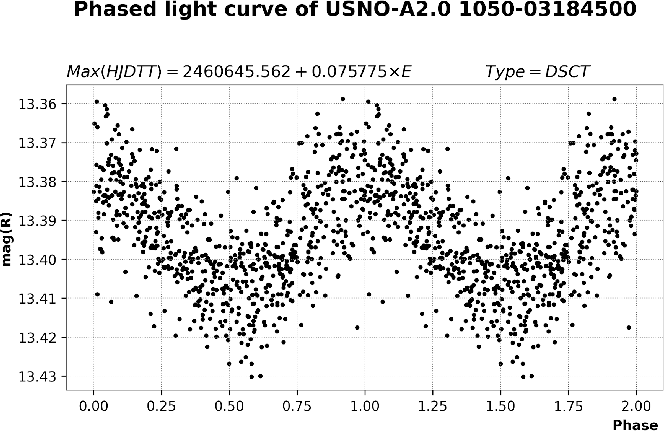|
Peremennye Zvezdy (Variable Stars) 45, No. 9, 2025 Received 6 June; accepted 11 June. |
Article in PDF |
|
DOI: 10.24412/2221-0474-2025-45-84-98
|
Variable stars in the field in Orion
A. Samokhvalov
- Sternberg Astronomical Institute, Moscow State University, Russia, e-mail: sav@surgut.ru
|
I present my photometric observations of a field in
Orion,
|
1. Introduction
Working at the program aimed at discoveries and studies of
variable stars using the Small Photometric Telescope of the
Caucasian Mountain Observatory, we studied a field in Orion with
coordinates of center of the frame:
![]() . In this field,
. In this field,
![]() in size, we investigated 27 variable
stars; for 15 of them, variability was discovered by the author.
The general information on these stars is collected in Table 1,
where equatorial coordinates were drawn from the Gaia DR3 catalog
(Gaia Collaboration, 2022). Some of these stars, marked as "K",
are currently contained in the AAVSO Variable Star Index (VSX)
(Watson et al., 2006); for stars marked "N", variability was
discovered in our study. Then follow the columns "Type" and
"Period" (in days). The column "Magnitude" contains the
variation range in the
in size, we investigated 27 variable
stars; for 15 of them, variability was discovered by the author.
The general information on these stars is collected in Table 1,
where equatorial coordinates were drawn from the Gaia DR3 catalog
(Gaia Collaboration, 2022). Some of these stars, marked as "K",
are currently contained in the AAVSO Variable Star Index (VSX)
(Watson et al., 2006); for stars marked "N", variability was
discovered in our study. Then follow the columns "Type" and
"Period" (in days). The column "Magnitude" contains the
variation range in the ![]() band derived from our photometric
measurements. The web site of the Small Photometric Telescope
(http://www.sai.msu.su/gcvs/telescope/) contains detailed
information about these variable stars, including light curves,
finding charts, and photometric measurements. The web site is
constantly being updated and maintained.
band derived from our photometric
measurements. The web site of the Small Photometric Telescope
(http://www.sai.msu.su/gcvs/telescope/) contains detailed
information about these variable stars, including light curves,
finding charts, and photometric measurements. The web site is
constantly being updated and maintained.
| No. | Star | RA J2000.0 h m s |
Dec J2000.0 |
Var | Type | Period, days | Magnitude, Rc |
| 1 | USNO-A2.0 1050-03144899 | 06:10:33.916 | +18:40:36.25 | K | BY | 2.040 | 14.42-14.55 |
| 2 | USNO-A2.0 1050-03153864 | 06:11:10.680 | +18:27:52.54 | N | DSCT | 0.133043 | 14.31-14.10 |
| 3 | USNO-A2.0 1050-03155163 | 06:11:16.094 | +18:24:48.32 | N | EA | 3.2906 | 15.17-15.48 |
| 4 | USNO-A2.0 1050-03156721 | 06:11:22.272 | +18:28:53.93 | N | BY | 0.9573 | 16.95-17.32 |
| 5 | USNO-A2.0 1050-03158028 | 06:11:27.585 | +18:44:03.68 | N | RS | 0.70535 | 13.89-13.96 |
| 6 | USNO-A2.0 1050-03158483 | 06:11:29.336 | +18:41:25.89 | K | BY | 10.617 | 14.32-14.42 |
| 7 | USNO-A2.0 1050-03159801 | 06:11:34.545 | +18:28:37.71 | N | SR | 31.9 | 14.46-14.58 |
| 8 | USNO-A2.0 1050-03160558 | 06:11:37.328 | +18:37:35.56 | K | EB | 0.49446 | 14.65-14.87 |
| 9 | USNO-A2.0 1050-03161672 | 06:11:41.465 | +18:26:23.28 | K | EB | 0.74883 | 14.13-14.50 |
| 10 | USNO-A2.0 1050-03166434 | 06:11:59.445 | +18:25:44.12 | K | EB | 1.0304 | 16.38-16.63 |
| 11 | 2MASS 06120210+1819082 | 06:12:02.102 | +18:19:08.32 | N | EA | 3.2473 | 13.15-13.45 |
| 12 | USNO-A2.0 1050-03169570 | 06:12:11.390 | +18:16:45.16 | K | EB | 0.36714 | 16.52-17.01 |
| 13 | USNO-A2.0 1050-03171745 | 06:12:19.746 | +18:37:44.92 | K | GDOR | 0.266134 | 12.55-12.59 |
| 14 | USNO-A2.0 1050-03174534 | 06:12:29.899 | +18:16:24.62 | N | SR: | 46.8 | 15.52-15.63 |
| 15 | USNO-A2.0 1050-03175801 | 06:12:34.604 | +18:28:13.89 | N | UV | 13.78-14.13 | |
| 16 | USNO-A2.0 1050-03179017 | 06:12:46.245 | +18:15:23.96 | N | DSCT | 0.087056 | 13.24-13.30 |
| 17 | USNO-A2.0 1050-03179518 | 06:12:47.981 | +18:40:09.50 | K | BY | 2.312 | 16.67-16.86 |
| 18 | 2MASS 06124827+1839278 | 06:12:48.274 | +18:39:27.91 | N | BY | 10.93 | 13.50-13.56 |
| 19 | USNO-A2.0 1050-03180562 | 06:12:51.969 | +18:42:40.63 | K | EB | 0.51240 | 16.80-17.60 |
| 20 | 2MASS 06130213+1844312 | 06:13:02.134 | +18:44:31.18 | K | BY | 2.087 | 15.17-15.28 |
| 21 | USNO-A2.0 1050-03183393 | 06:13:02.333 | +18:19:09.17 | K | BY | 1.945 | 15.58-15.73 |
| 22 | USNO-A2.0 1050-03184500 | 06:13:06.324 | +18:42:21.33 | N | DSCT | 0.075775 | 13.36-13.43 |
| 23 | USNO-A2.0 1050-03187336 | 06:13:16.584 | +18:33:17.08 | N | EB | 0.7048 | 16.40-16.63 |
| 24 | USNO-A2.0 1050-03187379 | 06:13:16.706 | +18:19:34.95 | K | BY | 4.910 | 14.90-14.99 |
| 25 | USNO-A2.0 1050-03187757 | 06:13:18.132 | +18:37:18.20 | N | EA | 5.2643 | 15.15-15.40 |
| 26 | USNO-A2.0 1050-03190192 | 06:13:26.531 | +18:18:12.95 | N | RS | 1.1167 | 14.06-14.13 |
| 27 | USNO-A2.0 1050-03191156 | 06:13:29.814 | +18:25:12.88 | N | BY | 12.15 | 13.91-13.95 |
Additional information about the program variable stars is given
in Table 2. Its first column contains the number from Table 1. VSX
Name for known variable stars was drawn from the corresponding
database. Values in the columns "IR indices and spectrum" are
based on infrared photometry from the 2MASS catalog of point
sources, cf. Cutri et al. (2003). The ![]() ,
, ![]() , and
, and ![]() color indices are presented only for stars with the AAA 2MASS
quality flag, Qflg. The estimated spectral types in the "Sp"
column are based on Bessell and Brett (1988). Note that, in some
cases (for example, for DSCT stars No. 2 and No. 16), these
color-based spectral type estimates appear too late; this can
result from considerable interstellar reddening for the stars
close to the galactic plane. The absolute magnitude
color indices are presented only for stars with the AAA 2MASS
quality flag, Qflg. The estimated spectral types in the "Sp"
column are based on Bessell and Brett (1988). Note that, in some
cases (for example, for DSCT stars No. 2 and No. 16), these
color-based spectral type estimates appear too late; this can
result from considerable interstellar reddening for the stars
close to the galactic plane. The absolute magnitude ![]() and
distance from the galactic plane
and
distance from the galactic plane ![]() , in parsecs, are based on
distances from the Sun given in Bailer-Jones et al. (2021).
, in parsecs, are based on
distances from the Sun given in Bailer-Jones et al. (2021).
| No. | VSX Name | IR indices and spectrum | M | Z | Remark | |||
| J – H | H – K | J – K | Sp | |||||
| 1 | Gaia DR3 | 0.586 | 0.147 | 0.733 | K | 6.20 | 20 | Suggested type BY, instead of |
| 3373644691583320448 | RS in VSX. Period derived | |||||||
| by us, not present in VSX. | ||||||||
| 2 | - | 0.563 | 0.141 | 0.704 | K | Multiperiodicity detected, | ||
| see Table 5. | ||||||||
| 3 | - | 0.375 | 0.173 | 0.548 | K | 4.40 | 20 | Uncertain period. |
| 4 | - | 0.912 | 0.362 | 1.274 | M | 6.40 | 21 | Suggested type BY. |
| 5 | - | 0.209 | 0.107 | 0.316 | F | 3.30 | 24 | Suggested type RS. |
| 6 | ZTF | 0.534 | 0.188 | 0.722 | K | 4.10 | 24 | Suggested type BY, instead of |
| J061129.33+184126.0 | RS in VSX. | |||||||
| 7 | - | 1.379 | 0.504 | 1.883 | M | 1.00 | 26 | |
| 8 | ZTF | 0.313 | 0.13 | 0.443 | G | 3.40 | 25 | Suggested type EB, instead of |
| J061137.32+183735.7 | EW in VSX. | |||||||
| 9 | ZTF | 0.272 | 0.141 | 0.413 | G | 3.20 | 22 | Suggested type EB, instead of |
| J061141.46+182623.3 | EW in VSX.
|
|||||||
| 10 | Gaia DR3 | 0.473 | 0.248 | 0.721 | 4.40 | 26 | Suggested type EB, instead of | |
| 3373627580433821824 | E in VSX.
|
|||||||
| 11 | - | 2.20 | 23 |
|
||||
| 12 | ZTF | 0.63 | 0.189 | 0.819 | K | 6.10 | 23 | Suggested type EB, instead of |
| J061211.39+181645.2 | EW in VSX.
|
|||||||
| 13 | Gaia | 0.122 | 0.09 | 0.212 | F | 2.90 | 25 | Multiperiodicity detected, |
| DR3 3373658018863384832 | see Table 5. | |||||||
| 14 | - | 0.595 | 0.175 | 0.77 | K | |||
| 15 | - | 0.582 | 0.233 | 0.815 | K-M | 9.90 | 21 | |
| 16 | - | 0.249 | 0.173 | 0.422 | G | 2.00 | 27 | Multiperiodicity detected, |
| see Table 5. | ||||||||
| 17 | ZTF | 0.536 | 0.095 | 0.631 | K | 4.80 | 38 | Suggested type BY, instead of |
| J061247.98+184009.5 | RS in VSX. | |||||||
| 18 | - | 0.402 | 0.094 | 0.496 | K | 5.30 | 24 | |
| 19 | ZTF | 0.567 | 0.124 | 0.691 | K | 5.40 | 37 | Suggested type EB, instead of |
| J061251.97+184240.6 | EW in VSX.
|
|||||||
| 20 | EPIC 202081450 | 0.591 | 0.254 | 0.845 | M | 10.20 | 22 | Suggested type BY, instead of |
| VAR in VSX. | ||||||||
| 21 | ZTF | 0.822 | 0.199 | 1.021 | M | 4.50 | 29 | Suggested type BY, instead of |
| J061302.33+181909.2 | RS in VSX. | |||||||
| 22 | - | 0.241 | 0.119 | 0.36 | G | 2.10 | 36 | Multiperiodicity detected, |
| see Table 5. | ||||||||
| 23 | - | 4.10 | 44 | |||||
| 24 | Gaia DR3 | 0.411 | 0.166 | 0.577 | G-K | 4.70 | 27 | Suggested type BY, instead of |
| 3373424583099320320 | RS, given in VSX. Period derived | |||||||
| by us, not present in VSX. | ||||||||
| 25 | - | 0.334 | 0.188 | 0.522 | K | 3.70 | 38 | Period 2 |
| 26 | - | 0.228 | 0.076 | 0.304 | F | 2.70 | 33 | Suggested type RS. |
| 27 | - | 0.348 | 0.119 | 0.467 | K | 5.30 | 25 | Suggested type BY. |
2. Observations, primary reductions, and magnitude calibration
Our observations were carried out at the Caucasian Mountain
Observatory (CMO) of M.V. Lomonosov Moscow State University (see
Shatsky et al., 2020) using a 0.25-m remote controlled
Ritchey-Chrétien telescope, equipped with a SBIG STXL-6303e CCD
camera and an ![]() filter. A total of 768 images of the field
with 600-second exposures were obtained on JD 2460614-2460785.
Information concerning the number of images taken on each
observing night is collected in Table 3.
filter. A total of 768 images of the field
with 600-second exposures were obtained on JD 2460614-2460785.
Information concerning the number of images taken on each
observing night is collected in Table 3.
| JD | Images | JD | Images | JD | Images | JD | Images | JD | Images |
| 2460614 | 8 | 2460654 | 11 | 2460683 | 2 | 2460704 | 12 | 2460751 | 24 |
| 2460627 | 12 | 2460665 | 16 | 2460684 | 4 | 2460706 | 20 | 2460752 | 21 |
| 2460632 | 6 | 2460666 | 20 | 2460685 | 20 | 2460707 | 20 | 2460755 | 19 |
| 2460637 | 16 | 2460669 | 19 | 2460686 | 25 | 2460708 | 15 | 2460756 | 13 |
| 2460645 | 15 | 2460671 | 7 | 2460691 | 8 | 2460718 | 19 | 2460757 | 14 |
| 2460646 | 17 | 2460675 | 19 | 2460696 | 18 | 2460739 | 25 | 2460759 | 2 |
| 2460647 | 17 | 2460676 | 12 | 2460697 | 21 | 2460740 | 2 | 2460785 | 7 |
| 2460648 | 7 | 2460677 | 21 | 2460698 | 2 | 2460743 | 21 | ||
| 2460649 | 18 | 2460678 | 14 | 2460700 | 15 | 2460745 | 14 | ||
| 2460651 | 20 | 2460679 | 16 | 2460702 | 23 | 2460748 | 26 | ||
| 2460652 | 12 | 2460680 | 19 | 2460703 | 21 | 2460750 | 13 |
For basic reductions for dark current, flat fields, bias, and for removing hot pixels and cosmic-ray hits, we used IRAF routines and primary reduction utilities from VaST software by Sokolovsky and Lebedev (2018). For calibration, each observing night, we obtained 100 bias frames, 16 dark frames, 16 flat fields, plus 16 dark frames corresponding to flat fields.
To search for new variable stars and to perform their photometry, we applied VaST software. All times in this paper are expressed in terrestrial time in accordance with IAU recommendations (resolution B1 XXIII IAU GA), with heliocentric corrections applied.
For magnitude calibration in ![]() band, we use data of the GAIA
DR3 catalogue. We restrict ourselves to single, relatively bright
stars, with no saturation of pixels for our CCD camera, no close
neighbors, and demonstrating no brightness variations during the
time interval of our observations. Detailed information about our
calibration stars is collected in Table 4. Uncertainties in the
band, we use data of the GAIA
DR3 catalogue. We restrict ourselves to single, relatively bright
stars, with no saturation of pixels for our CCD camera, no close
neighbors, and demonstrating no brightness variations during the
time interval of our observations. Detailed information about our
calibration stars is collected in Table 4. Uncertainties in the
![]() column were derives from our photometry, the GAIA
column were derives from our photometry, the GAIA
![]() ,
, ![]() , and
, and ![]() magnitudes were drawn from the
corresponding catalog. Magnitudes in the
magnitudes were drawn from the
corresponding catalog. Magnitudes in the ![]() column were
obtained using the equation:
column were
obtained using the equation:
| (1) |
which is based on Table 5.9 of Gaia Data Release 3, Documentation release 1.3 (https:// gea.esac.esa.int/archive/documentation/GDR3/).
| GSC | σ Rc | GAIA | Rc calc | ||
| G | GBP | GRP | |||
| 3968-2621 | 0.008 | 11.5102 | 12.5060 | 10.5323 | 12.2394 |
| 3968-3272 | 0.007 | 12.1790 | 12.5445 | 11.6340 | 12.3610 |
| 3968-3000 | 0.008 | 12.3394 | 12.5281 | 12.0156 | 12.4139 |
| 3968-2894 | 0.007 | 12.0446 | 12.3314 | 11.5923 | 12.1732 |
| 3968-2595 | 0.007 | 11.8378 | 12.1974 | 11.3031 | 12.0143 |
| 3968-2517 | 0.007 | 12.0227 | 12.2059 | 11.7003 | 12.0958 |
3. Further reductions of observations
To derive periods of pulsating variable stars, we use Period04 software by Lenz and Breger (2005) that implements the discrete Fourier transform, very suitable for analisys of sine-like light curves of the pulsating variable stars with multiperiodicity.
To process observations of eclipsing variable stars, we use
Peranso software by Paunzen and Vanmunster (2016) that implements
the Lafler-Kinman method, very suitable for the analysis of
asymmetric light curves, like those of Algol-type variable stars
(cf. Lafler and Kinman, 1965). For DSCT variable stars with
multiperiodicity (see Table 5), we searched for periodic signals
in our observations in the frequency range between 3 and 20 cycles
per day that was selected following recommendations by Breger
(2000), and for GDOR stars, between 1 and 6 cycles per day. We
continuously calculate significant frequencies: in the first
iteration, based on the original data; in the following
iterations, using residuals, as long as the signal-to-noise ratio
for the corresponding peak in the Fourier frequency spectrum
exceeds 4. This is the empirical criterium obtained from
observational analysis by Breger et al. (1993), it ensures that
the signal is a real feature. Parameters of the oscillations,
corresponding to the equation:
| (2) |
For plotting light curves, Fourier spectra, and population distribution diagrams, we applied our own routines, written in Python 3 programming language using the NumPy (Harris et al., 2020), Matplotlib (Hunter, 2007), and Seaborn (Waskom, 2021) libraries.
4. Classification of variable stars
Classification of variable stars given in Table 1 is based on the
GCVS classification system, see Samus et al. (2017). During our
analysis of photometric measurements, we found out that most known
variable stars require clarification of their type of variability,
because the variability types given in VSX do not correspond to
their photometric behavior, or to their absolute magnitude, or to
the estimated spectral type (see Table 2). The variability types
suggested by us are given in Table 1. An additional instrument of
classification are population distribution diagrams. Based on VSX
and 2MASS catalogs, we draw population distribution diagrams of
two types of variable stars as function of infrared colors derived
from 2MASS photometry: see Fig. 1 for DSCT (DSCT, DSCTC, and HADS)
stars and Fig. 2 for GDOR stars. Only stars with good 2MASS
photometry (![]() AAA) and reliably determined type of
variability (without ":" in the VSX type) were used. All new
variable stars also have the AAA 2MASS
AAA) and reliably determined type of
variability (without ":" in the VSX type) were used. All new
variable stars also have the AAA 2MASS ![]() quality flag and
are located on this diagram near the core of maximum population
density, in the green and blue zones. This can be considered one
of the signs of really belonging to the corresponding type of
variability.
quality flag and
are located on this diagram near the core of maximum population
density, in the green and blue zones. This can be considered one
of the signs of really belonging to the corresponding type of
variability.
 |
Fig. 1.
Population distribution diagram of DSCT
stars as function of 2MASS infrared colors |
 |
Fig. 2.
Population distribution diagram of GDOR
stars as function of 2MASS infrared colors |
Based on VSX data and distances from the Galactic plane, derived
using the distance from the Sun given in Bailer-Jones et al.
(2021), we draw a population distribution diagram of GDOR variable
stars as a function of period duration (Fig. 3, panel a) and
as a function of distance from the galactic plane (Fig. 3, panel
b). Period of the variable star USNO-A2.0 1050-03171745 (see
Table 1) is located near the maximum of the distribution of
periods of GDOR stars, and its distance from the galactic plane
(see Table 2) also corresponds to the maximum of the distribution
of distances ![]() of GDOR stars. This also can be considered as an
important sign of this star belonging to the GDOR variability
type.
of GDOR stars. This also can be considered as an
important sign of this star belonging to the GDOR variability
type.
 |
Fig. 3. Population distribution diagrams of GDOR stars: (a) as a function of period duration; (b) as a function of distance from the galactic plane. |
| USNO-A2.0 | N | merror | mmean | Oscillations | ||||
| Freqi | Frequency, d–1 | Φi | Ai, mag | SNR | ||||
| 1050-03153864 | 679 | 0.006 | 14.3590 | f1 f2 |
7.51638 3.75692 |
0.07100 0.96877 |
0.0230 0.0117 |
28.66 10.54 |
| 1050-03171745 | 674 | 0.0020 | 12.5726 | f1 f2 f3 f4 |
3.75750 2.64306 2.33750 2.93124 |
0.23444 0.65313 0.69009 0.98177 |
0.0057 0.0045 0.0019 0.0018 |
14.14 10.17 4.39 4.17 |
| 1050-03179017 | 674 | 0.0029 | 13.2662 | f1 f2 f3 f4 |
11.48688 10.76236 10.85308 12.46477 |
0.60546 0.84245 0.19095 0.13097 |
0.0122 0.0047 0.0040 0.0029 |
21.36 7.72 6.59 5.47 |
| 1050-03184500 | 678 | 0.0031 | 13.3943 | f1 f2 f3 f4 |
13.19696 14.01743 13.31354 10.71632 |
0.68279 0.13860 0.85135 0.89828 |
0.0117 0.0073 0.0052 0.0026 |
21.08 13.48 9.38 4.22 |
5. Interesting variable stars
Here we provide information about the most interesting variable stars from Table 1 that deserve special attention.
5.1. USNO-A2.0 1050-03153864
Variability of this star was discovered in our study. The star's multiperiodicity was detected, see Table 5. This is one of the faintest star with multiperiodic pulsations detected in this field, and we found only two significant frequencies.
Figure 4 presents the frequency spectrum of USNO-A2.0 1050-03153864 and its theoretical light curve (solid curve) with superposed data points corresponding to individual observations.
 |
Fig. 4. Frequency spectrum and light curve of USNO-A2.0 1050-03153864. In the bottom panel, the solid curve is the synthesized light curve and dots are observed data points. |
The phased light curve of USNO-A2.0 1050-03153864 with the
following light elements:

in filter
5.2. USNO-A2.0 1050-03171745
This is a known variavle star, it is contained in the GAIA DR3
Variability Catalog, though without period. Using our photometric
measurements, we found four pulsation modes with frequencies
satisfying the ![]() criterion (Table 5).
criterion (Table 5).
Figure 6 presents the frequency spectrum of USNO-A2.0 1050-03171745 and its theoretical light curve (solid curve) with superposed data points corresponding to individual observations. Light curve variations are easy to notice, they are reproduced with the model rather well.
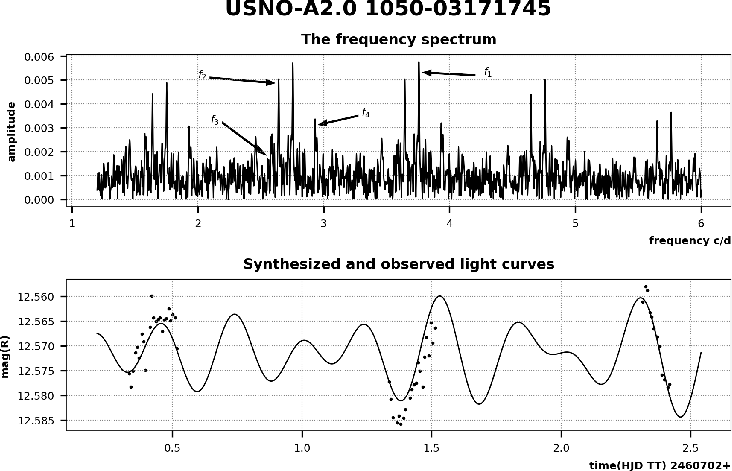 |
Fig. 6. Frequency spectrum and light curve of USNO-A2.0 1050-03171745. In the bottom panel, the solid curve is the synthesized light curve and dots are observed data points. |
The phased light curve of USNO-A2.0 1050-03171745 with the
following light elements:
in filter
5.3. USNO-A2.0 1050-03175801
Variability of this star was discovered in our study. During the
observing campaign, the star did not demonstrate variability, but
it flared by 0![]() 35 on 2025 January 31 (Fig. 8). The actual
amplitude may be higher than the given value because the exposure
time of a single image, 600 seconds, can reduce amplitudes of fast
flares.
35 on 2025 January 31 (Fig. 8). The actual
amplitude may be higher than the given value because the exposure
time of a single image, 600 seconds, can reduce amplitudes of fast
flares.
The 2MASS color indices and absolute magnitude in ![]() filter
(see Table 2) correspond to a dwarf of a K or M spectral type,
typical of UV Ceti variable stars.
filter
(see Table 2) correspond to a dwarf of a K or M spectral type,
typical of UV Ceti variable stars.
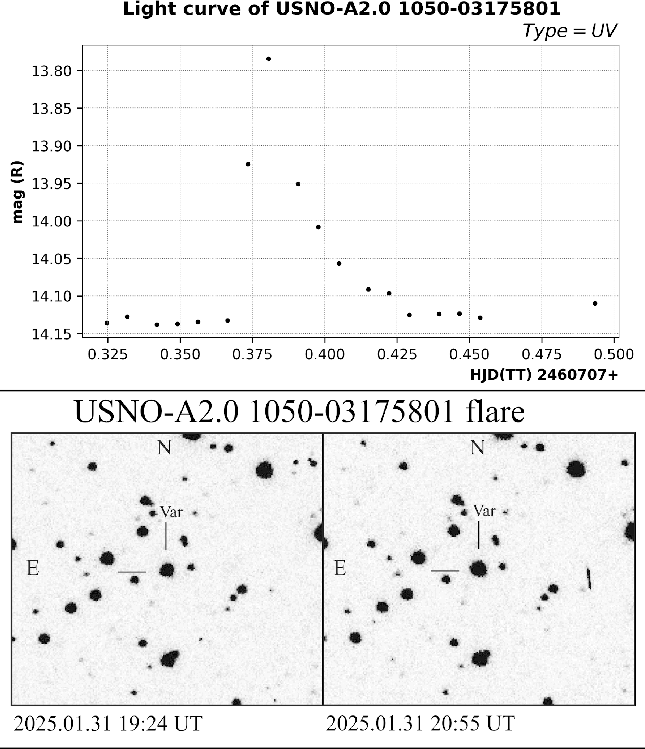 |
Fig. 8. The flare of USNO-A2.0 1050-03175801: light curve and images. Left: quiet state, right: flare. |
5.4. USNO-A2.0 1050-03179017
Variability of this star was discovered in our study. We detected multiperiodicity (Table 5). The frequency spectrum of USNO-A2.0 1050-03179017 and its theoretical light curve (solid curve) with superposed data points corresponding to individual observations are shown in Fig. 9. Light curve variations are easy to notice, they are reproduced with the model rather well.
 |
Fig. 9. Frequency spectrum and light curve of USNO-A2.0 1050-03179017. In the bottom panel, the solid curve is the synthesized light curve and dots are observed data points. |
The phased light curve of USNO-A2.0 1050-03179017 with the
following light elements:
in filter
5.5. USNO-A2.0 1050-03184500
Variability of this star was discovered in our study. We detected multiperiodicity (see Table 5). Fig. 11 presents the frequency spectrum of USNO-A2.0 1050-03184500 and its theoretical light curve (solid curve) with superposed data points corresponding to individual observations.
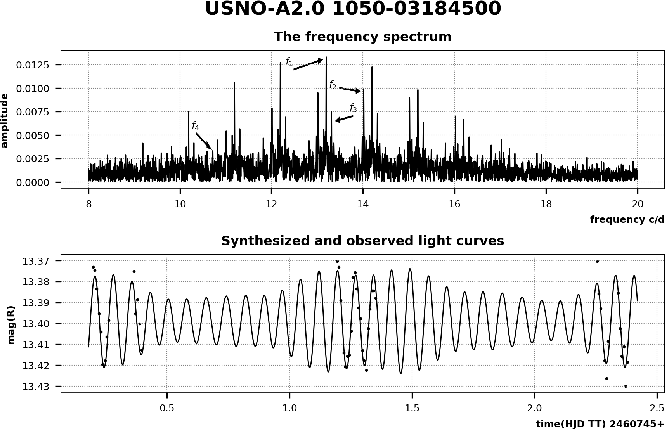 |
Fig. 11. Frequency spectrum and light curve of USNO-A2.0 1050-03184500. In the bottom panel, the solid curve is the synthesized light curve and dots are observed data points. |
The phased light curve of USNO-A2.0 1050-03184500 with the
following light elements:
in filter
6. Conclusion
We studied 27 variable stars, among which, three DSCT stars and one GDOR star demonstrate reliable signs of multiperiodical pulsations. We also observed one flare of a new UV Ceti star. All detected frequencies of multiperiodic pulsating stars are real features of their oscillations.
For 11 known variable stars in the observed field, we clarified
the type of variability. The number of interesting variable stars
in a small field (0.42 square degrees) being that large is a good
reason to continue the program aimed at searching for variable
stars and studying variable stars at low galactic latitudes in
dense star fields. All materials of the present study, including
finding charts, light curves, photometric measurements, etc. are
available at the web site of the Small Photometric Telescope
(http://www.sai.msu.su/gcvs/telescope/).
Acknowledgements: I would like to thank Prof. N. N. Samus for helpful discussion. The study was conducted under the state assignment of Lomonosov Moscow State University.
References:
Bailer-Jones, C. A. L., Rybizki, J., Fouesneau, M., et al., 2021, Astron. J., 161, No. 3, article id. 147
Bessell, M. S. & Brett, J. M., 1988, Publ. Astron. Soc. Pacific, 100, 1134
Breger, M., 2000, ASP Conference Series, 210, Breger, M. & Montgomery, M. (eds.), 3
Breger, M., Stich, J., Garrido, R., et al. 1993, Astron. & Astrophys., 271, 482
Cutri, R. M., Skrutskie, M. F., van Dyk, S., et al., 2003, 2MASS All Sky Catalog of Point Sources, Centre de Donnees Astronomiques de Strasbourg, II/246
Gaia Collaboration, 2022, VizieR On-line Data Catalog: I/355
Hunter, J. D., 2007, Computing in Science & Engineering, 9, No. 3, 905
Harris, C. R., Millman, K. J., van der Walt, S. J. et al., 2020, Nature, 585, issue 7825, 357
Lafler, J. & Kinman, T. D., 1965, Astrophys. J., Suppl. Ser., 11, 216
Lenz, P. & Breger, M. 2005, Communications is Asteroseismology, 146, 53
Monet, D., Bird, A., Canzian, B., et al., 1998, USNO-A V2.0, A Catalog of Astrometric Standards, Centre de Donnees Astronomiques de Strasbourg, I/252
Paunzen, E. & Vanmunster, T., 2016, Astron. Nachr., 337, No. 3, 239
Samus, N. N., Kazarovets, E. V., Durlevich, O. V., et al., 2017, Astron. Rep., 61, No. 1, 80
Shatsky, N., Belinski, A., Dodin, A., et al., 2020, in: Ground-Based Astronomy in Russia. 21st Century, Romanyuk, I. I., Yakunin, I. A., Valeev, A. F., & Kudryavtsev, D. O. (eds.), 127
Sokolovsky, K. V. & Lebedev, A. A., 2018, Astron. & Computing, 22, 28
Waskom, M. L., 2021, Journal of Open Source Software, 6(60),
3021,
https://doi.org/10.21105/joss.03021
Watson, C. L., Henden, A. A., & Price, A. 2006, 25th Annual Symposium, The Society for Astronomical Sciences, 47
